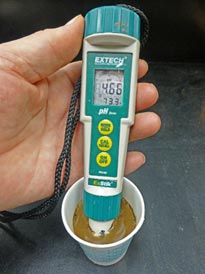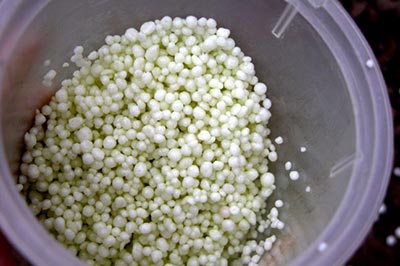Cotton farmers who work to strengthen their soil’s health reap the rewards of stronger crops and better yields. Two factors particularly affect cotton soil fertility — the soil’s acidity and the amount of nitrogen it contains. Read more for information on ways to test for and improve these key soil components.
Acidity

in soil (showing pH of 4.66)
The most important soil test for cotton crops is a measure of its pH value.
A pH test shows whether a soil is acid. The optimum pH for cotton is around 6.5. Low pH values can cause aluminum and manganese toxicity problems in cotton. Leaves on young cotton plants with toxicity problems crinkle and cup and look similar to those with thrips insect damage.
Control
Lime applications are used to neutralize acid in soils. Agricultural distributors in southeast Missouri sell lime made from calcite and dolomite rocks, with the lime from dolomite incorporating more magnesium than lime from calcite.
Field research with cotton at the University of Missouri’s Fisher Delta Research Center has shown that dolomite and calcite lime materials are equally effective in increasing yields when applied on acid soil at recommended rates of application. Cotton farmers with well-drained delta soils should not be concerned about any potential negative effects of magnesium in dolomite lime material. To learn more about the research published in the Journal of Cotton Science, go to “Soil Calcium: Magnesium Ratios and Lime Recommendations for Cotton.”
The rating system to evaluate lime is called effective neutralizing material (ENM). It is based on two factors: calcium carbonate equivalence and particle size. Learn more by reading “Missouri Limestone Quality: What Is ENM?”
Nitrogen
Cotton plants use only a small amount of nitrogen in the seedling stage. The heaviest demand for nitrogen is during the fruiting stages of squaring and boll formation, but the amount of nitrogen required for optimum yields varies with the situation.
Based on MU Fisher Delta Research Center studies, 80–120 pounds of nitrogen (N) is the recommended total amount for the season of N per acre in irrigated, continuous cotton on a sandy loam or silt loam soil having a yield potential of two or more bales per acre. It can be split so that one-third of the total N is pre-plant and the remainder side-dressed at pre-bloom, or the entire 80 to 120 pounds can be side-dressed before bloom. Nonstressed cotton can be side-dressed until about three weeks after first bloom with good results.
In the case of nonirrigated cotton, or where cotton follows soybeans or corn (with a likelihood of residual nitrogen), the nitrogen rate should probably be reduced.
Control

Cotton farmers can use stabilizer additives and urea with polymer coatings to improve the efficiency of nitrogen fertilizer. Example products are Agrotain and ESN fertilizer.
Broadcast urea fertilizer treated with N-(n-butyl) thiophosphoric triamide (NBPT) reduces volatilization losses from the soil surface compared to regular urea. Controlled-release nitrogen fertilizer is blended with urea to prevent losing most of the nitrogen to denitrification and leaching after excessive rainfall. Controlled-release fertilizer is polymer-coated.
The danger of applying all of the nitrogen in the controlled-release form is that too much could become available late in the season, resulting in delayed boll maturity.